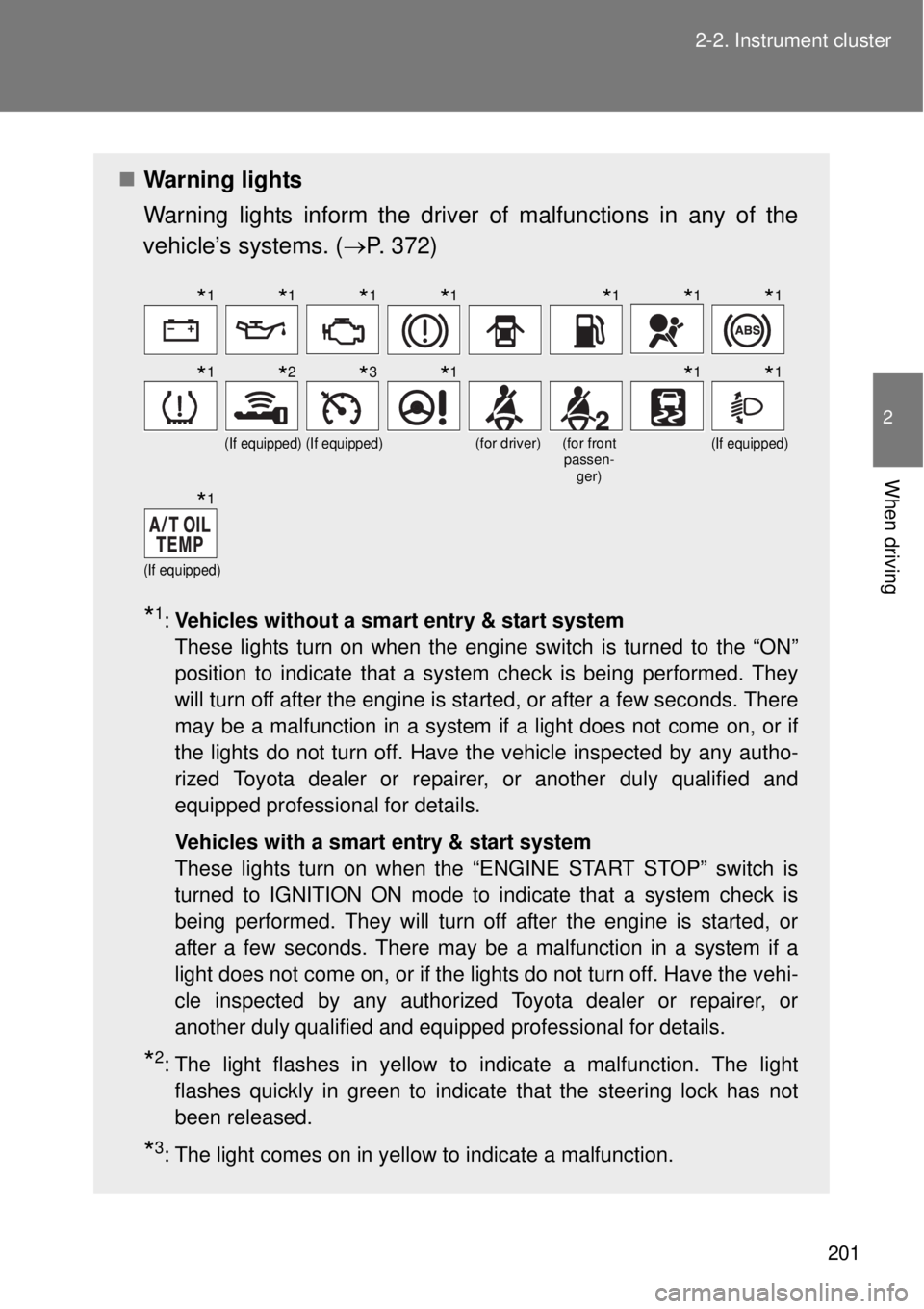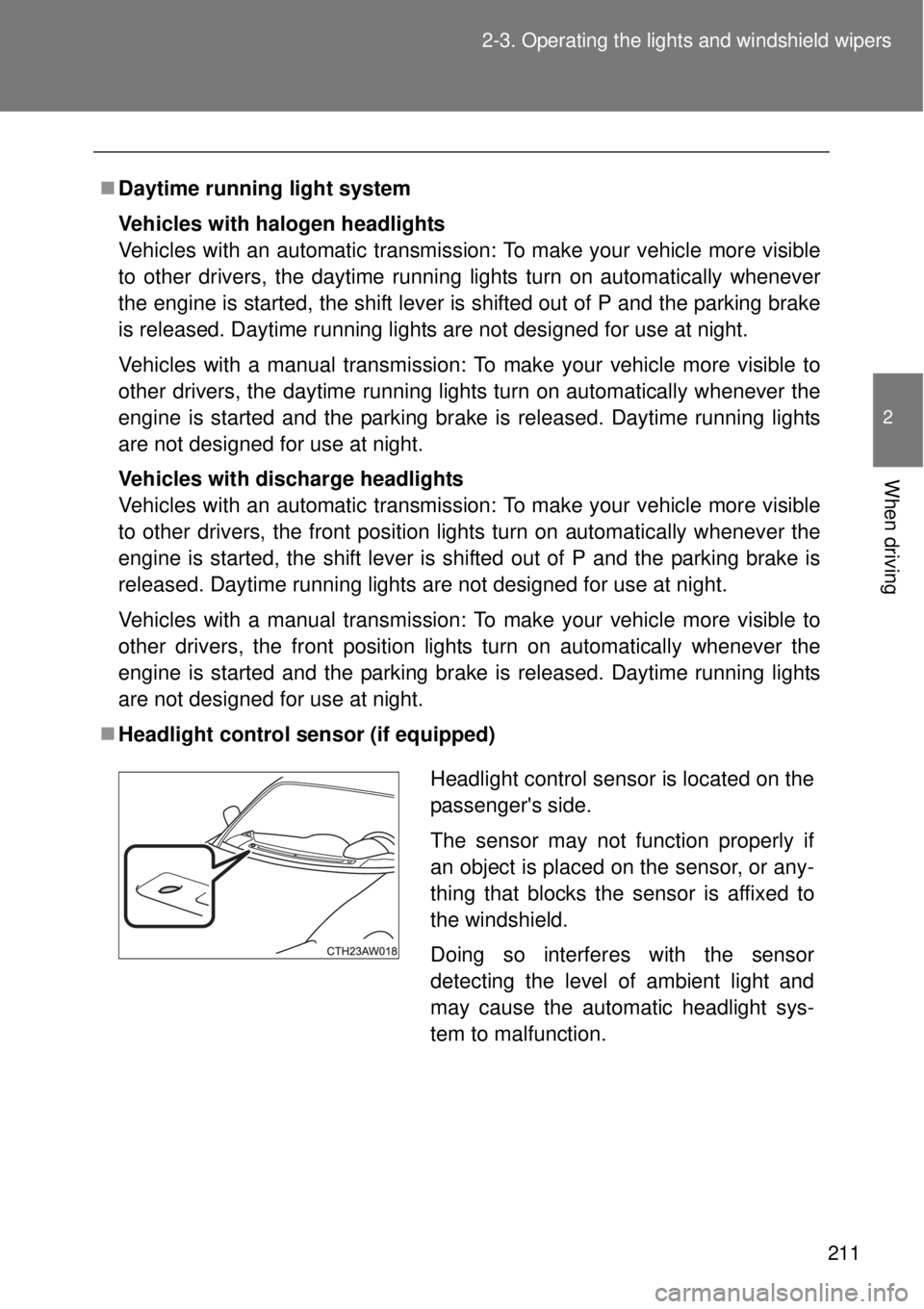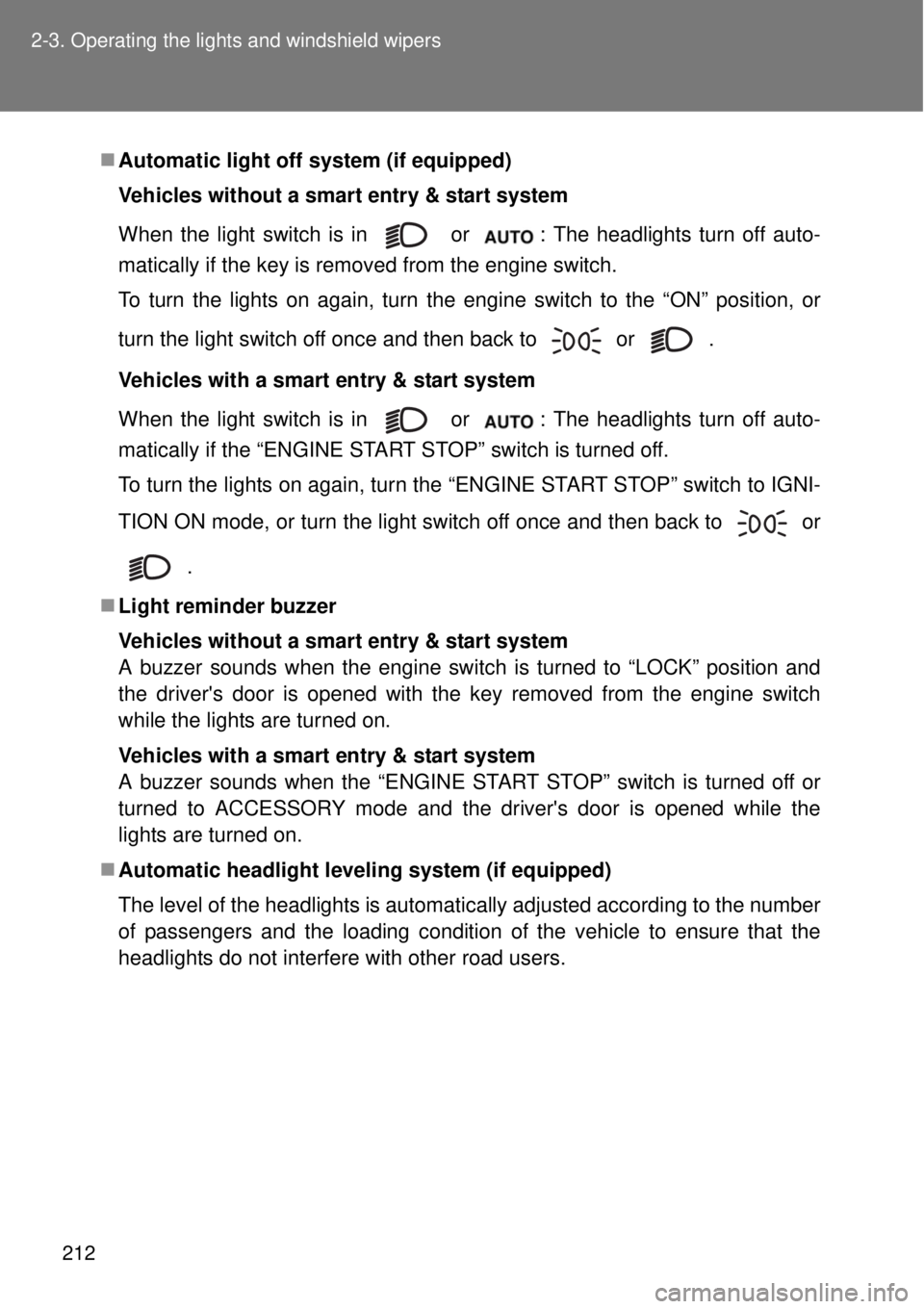Page 201 of 464

201 2-2. Instrument cluster
2
When driving
Warning lights
Warning lights inform the driver of malfunctions in any of the
vehicle’s systems. (P. 372)
*1:Vehicles without a smart entry & start system
These lights turn on when the engine switch is turned to the “ON”
position to indicate that a system check is being performed. They
will turn off after the engine is started, or after a few seconds. There
may be a malfunction in a system if a light does not come on, or if
the lights do not turn off. Have the vehicle inspected by any autho-
rized Toyota dealer or repairer, or another duly qualified and
equipped professional for details.
Vehicles with a smart entry & start system
These lights turn on when the “ENGINE START STOP” switch is
turned to IGNITION ON mode to indicate that a system check is
being performed. They will turn off after the engine is started, or
after a few seconds. There may be a malfunction in a system if a
light does not come on, or if the lights do not turn off. Have the vehi-
cle inspected by any authorized Toyota dealer or repairer, or
another duly qualified and equipped professional for details.
*2: The light flashes in yellow to indicate a malfunction. The light
flashes quickly in green to indicate that the steering lock has not
been released.
*3: The light comes on in yellow to indicate a malfunction.
(If equipped)(If equipped)(for driver)(for front
passen-
ger)(If equipped)
(If equipped)
*1*1*1*1*1*1*1
*1*2*3*1*1*1
*1
Page 202 of 464
202 2-2. Instrument cluster
CAUTION
If a safety system warning light does not come on
Should a safety system light such as the ABS and SRS warning light not
come on when you start the engine, this could mean that these systems are
not available to help protect you in an accident, which could result in death
or serious injury. Have the vehicle inspected by any authorized Toyota dealer
or repairer, or another duly qualified and equipped professional immediately
if this occurs.
Page 205 of 464
205 2-2. Instrument cluster
2
When driving
Setting the REV indicator (if equipped)
Changing the REV indicator settings
The engine speed at which the REV indicator turns on at and
whether a buzzer sounds or not when the light turns on can be set.
Engine speed setting range: From 2000 to 7400 rpm (r/min)
Press the “DISP” switch repeatedly until the setting screen is
displayed. (P. 204)
Press and hold the “DISP”
switch.
“REV.” and the thousandth place
flash. After flashing, the number
changes each time the button is
pressed and held.
Press the “DISP” switch.
The hundredth place flashes.
After flashing, the number
changes each time the button is
pressed and held.
Press the “DISP” switch.
A buzzer sounds once, and setting of the engine speed value is
complete.
STEP 1
STEP 2
STEP 3
STEP 4
Page 208 of 464
208
2-3. Operating the lights and windshield wipers
Headlight switch
The headlights can be operated manually or automatically.
Turning the end of the lever turns on the lights as follows:
Off
The daytime running lights
turn on.
The headlights, front
position, daytime run-
ning lights and so on
turn on and off auto-
matically. (Vehicles
without a smart entry &
start system: When the
engine switch is in the
“ON” position
Vehicles with a smart
entry & start system:
When the “ENGINE
START STOP” switch is
in IGNITION ON mode)
The front position, tail,
license plate and instru-
ment panel lights turn
on.
The headlights and all
the lights listed above
(except daytime run-
ning lights) turn on.
(if equipped)
Page 209 of 464
209 2-3. Operating the lights and windshield wipers
2
When driving
Turning on the high beam headlights
With the headlights on, push
the lever forward to turn on the
high beams.
Pull the lever back to the center
position to turn the high beams
off.
Pull the lever toward you and
release it to flash the high
beams once.
You can flash the high beams
with the headlights on or off.
Page 210 of 464
210 2-3. Operating the lights and windshield wipers
Manual headlight leveling dial (if equipped)
The level of the headlights can be adjusted according to the number
of passengers and the loading condition of the vehicle.
Raises the level of the head-
lights
Lowers the level of the head-
lights
Guide to dial settings
Occupancy and luggage load conditionsDial positionOccupantsLuggage load
Driver None 0
Driver and front
passengerNone 0
All seats occupied None 1
All seats occupied Full luggage loading 2
Driver Full luggage loading 2
Page 211 of 464

211 2-3. Operating the lights and windshield wipers
2
When driving
Daytime running light system
Vehicles with halogen headlights
Vehicles with an automatic transmission: To make your vehicle more visible
to other drivers, the daytime running lights turn on automatically whenever
the engine is started, the shift lever is shifted out of P and the parking brake
is released. Daytime running lights are not designed for use at night.
Vehicles with a manual transmission: To make your vehicle more visible to
other drivers, the daytime running lights turn on automatically whenever the
engine is started and the parking brake is released. Daytime running lights
are not designed for use at night.
Vehicles with discharge headlights
Vehicles with an automatic transmission: To make your vehicle more visible
to other drivers, the front position lights turn on automatically whenever the
engine is started, the shift lever is shifted out of P and the parking brake is
released. Daytime running lights are not designed for use at night.
Vehicles with a manual transmission: To make your vehicle more visible to
other drivers, the front position lights turn on automatically whenever the
engine is started and the parking brake is released. Daytime running lights
are not designed for use at night.
Headlight control sensor (if equipped)
Headlight control sensor is located on the
passenger's side.
The sensor may not function properly if
an object is placed on the sensor, or any-
thing that blocks the sensor is affixed to
the windshield.
Doing so interferes with the sensor
detecting the level of ambient light and
may cause the automatic headlight sys-
tem to malfunction.
Page 212 of 464

212 2-3. Operating the lights and windshield wipers
Automatic light off system (if equipped)
Vehicles without a smart entry & start system
When the light switch is in or
: The headlights turn off auto-
matically if the key is removed from the engine switch.
To turn the lights on again, turn the engine switch to the “ON” position, or
turn the light switch off once and then back to
or .
Vehicles with a smart entry & start system
When the light switch is in or
: The headlights turn off auto-
matically if the “ENGINE START STOP” switch is turned off.
To turn the lights on again, turn the “ENGINE START STOP” switch to IGNI-
TION ON mode, or turn the light switch off once and then back to
or
.
Light reminder buzzer
Vehicles without a smart entry & start system
A buzzer sounds when the engine switch is turned to “LOCK” position and
the driver's door is opened with the key removed from the engine switch
while the lights are turned on.
Vehicles with a smart entry & start system
A buzzer sounds when the “ENGINE START STOP” switch is turned off or
turned to ACCESSORY mode and the driver's door is opened while the
lights are turned on.
Automatic headlight leveling system (if equipped)
The level of the headlights is automatically adjusted according to the number
of passengers and the loading condition of the vehicle to ensure that the
headlights do not interfere with other road users.